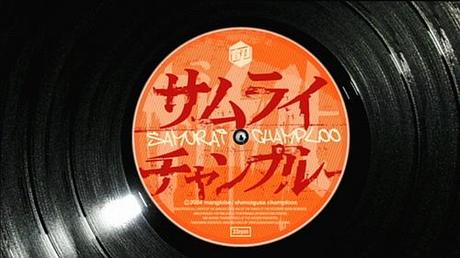
Samurai Champloo is a 26-episode anime series directed by Schinichiro Watanabe, who also did Cowboy Bebop. Like Bebop, it is episodic, following the adventures of Fuu, Mugen, and Jin, as they look for the samurai who smells like sunflowers (Fuu’s father). Both Mugen and Jin are skilled fighters; Mugen is an ex-pirate, Jin is a ronin, a samurai without a master. Fuu worked as a waitress.
Like Bebop’s, Champloo’s mise en scène is culturally eclectic. It is also anachronistic. But the mix is different. Bebop is set in the future and in space, mostly Mars, its moons, and asteroids. As the name suggests, the music is nods toward jazz. “Cowboy” is slang for bounty hunter, which is the default profession of the four central characters (five if you count the dog). Champloo is set in Edo-era Japan – roughly the two and a half centuries before Perry arrived. The title theme is hip hop, and hip hop occurs in the soundtrack, imagery, and thematics.
This note is about two episodes that are relatively late in the series. Each involves an encounter between Japan and America, but only one is staged that way. One is about tagging & Andy Warhol and the sign (of the word), the other about baseball. Note that baseball was first played in Japan in 1872 and has been played more or less continuously since then.
Tagging Warhol
The English title for episode 18 is “War of the Words.” What interests me about this episode is simply its emphasis on the printed word (plot summary). Running through the episode we have rival gangs fighting, not through physical violence against one another, but through tagging. The episode is framed by voice over about fashion and the street, delivered by the guy in the middle:
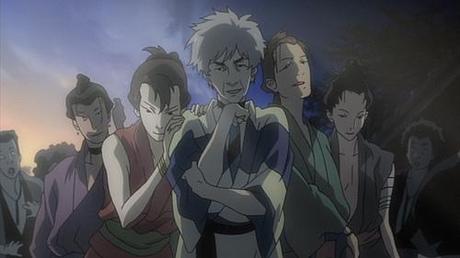
The image itself may or may not proclaim “Andy Warhol” to you (do look at the hair), but the reference is obvious enough in context. I have no sense of how obvious the reference would be to an audience too young to have been aware of Warhol when he was alive (he died in 1987). I have no idea about Warhol’s acceptance in Japan, but pretty much assume he was well-known there simply because he was one of the best-known art-world figures of the time.
Here we have the Niwa brothers:

Notice the hair styles, the piercings, and the (mostly obscured) graffiti behind them. They’d inherited a dojo from their father, but were not trained martial artists. The brothers have been feuding, leading rival gangs in tagging the local public spaces. Jin – one of the Champloo’s core trio – suggests they settle the matter with a tagging contest. The gang that scores the most spectacular tag wins.
They both lose. They’re beaten by Mugen, another of the core trio. Mugen painted an infinity sign – his personal symbol – on the roof of Hiroshima castle — and what important event in Japanese-American history took place in Hiroshima?
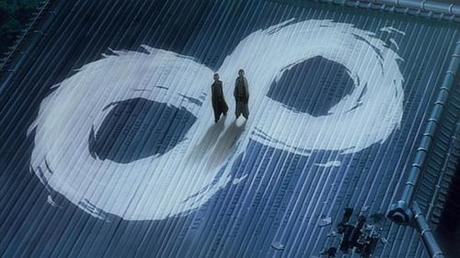
This episode is not staged as an encounter between Japan and the West. I can all but imagine an argument denying that it is, in fact, an encounter between Japan and America. Among other things, this argument would have to bracket Warhol’s origins, perhaps by arguing that the anachronism that is at the stylistic heart of the series assumes that Warhol, and graffiti, is always already there, in Japan as everywhere. That seems doable, but I leave it as an exercise for the reader.
Play Ball
In contrast, episode 23 is quite explicitly staged as Japan-American encounter (plot summary). After a prelude about the success of Japanese players in American baseball, and a set-up involving a feast the trio cannot pay for, we have a baseball game.
An American ship lands and demands trade. They play a baseball game with the Japanese and loose by forfeit at the end of the first inning. Consequently, they leave.
Here’s the two teams lined up before the game. The Japanese team looks, well, rather irregular. The American team looks well-fed, and they look pretty much alike:
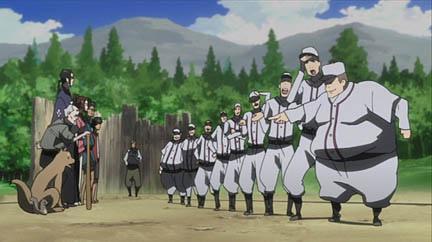
The Japanese are up first and score two runs. Here’s the bottom of their batting order, a rather differentiated crew:
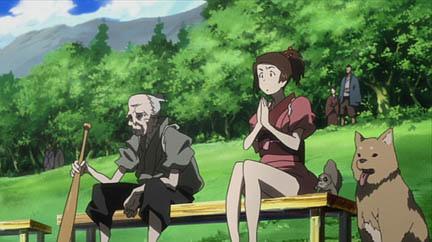
The woman is Fuu, the third continuing character in the series. The dog and Fuu’s pet squirrel are on the team as well. The old man, the village elder, dies while walking to the plate.
Mugen adopts a two-bat style, no doubt derived from a martial arts discipline:
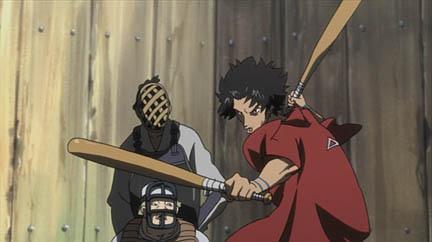
And then we have this iconic gesture from Manzou the Saw (a recurring character):

Naturally, the coach kept signing for him to bunt. He didn’t. Got a hit. And died when he one of the American players landed on him, twice.
And so the Japanese are retired. Just what happens when the Americans get up to bat is a bit complicated. But the upshot is all are so badly injured that they cannot play. With one Japanese player left standing, Mugen, the Japanese team wins by forfeit.
This episode is quite obviously and pointedly staged as an encounter between Japan and America. The particular style of the encounter is worth a remark or two, as is the fact that the Japanese won the game. Given Japanese awareness of their special relationship with America, not to mention article 9 of the Japanese constitution (which prohibits Japan from going to war), that is not a casual matter. One should also consider that this series was almost surely planned and executed knowing that it would be shown in America.
I leave consideration of these various matters as an exercise for the reader.

